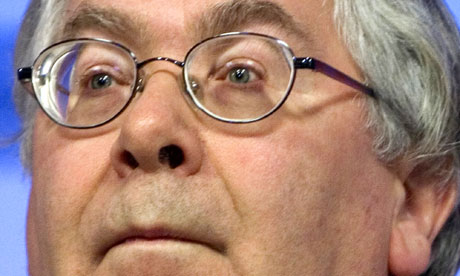Mervyn King has turned our leaders into zombie puppets
Demand has not risen. Neither has production. Yet we have been duped into thinking that QE will kickstart the economy

‘This enormous sum does not exist and never has. It is not "printed" money or funny money. It is no money.' Photograph: Chris Radcliffe/AP
It must be the biggest confidence trick of all time. It is a cheat, a scam, a fiddle, a bankers' ramp, a revenge of big money against an ungrateful world. It is called quantitative easing, and nobody has a clue what it means. According to the Bank of England, the past four years have seen £325bn pumped into the British economy to kickstart growth, with another £50bn now on the way. This enormous sum does not exist and never has. It is not "printed" money or funny money. It is no money. The one silver bullet on which the coalition relies to pull Britain out of recession is a fiction.
I have spent the last year trying to find this money, if only because it seemed rather a lot – more than an entire annual take from income tax, VAT and corporation tax together. I have asked bankers, regulators, commentators, economists, and even trotted round to the Bank of England. Ask any of them after the £325bn and they stare at the ceiling or look at their shoes. Nobody knows. The money appears in no statistic of cash in circulation or on deposit. Bank balances have not altered. Demand has not risen. Production has not expanded.
Such professional and intellectual gullibility on a matter of national salvation is staggering. When Alistair Darling, as Labour chancellor, "pumped in" £75bn, he said it would stave off recession. George Osborne, then shadow chancellor, derided it as "the last resort of desperate governments", and Vince Cable said Britain was going down the road to Harare and hyperinflation. Yet when these two men came to power, they were overnight converts. They became zombie puppets of the Bank of England and its boss, Sir Mervyn King.
We know what QE is supposed to do. The Bank "buys back" the government bonds (or gilts) that were previously sold to banks. Since gilts are as good as cash, this merely replaces an interest-bearing bond with actual cash on the asset side of a bank's balance sheet. It is a paper transaction, moving sums from the bonds column to the cash column.
In theory, the banks have an interest in lending that cash at a profit to the public, or to companies. But that depends on buoyant demand and on finding businesses and individuals whose credit is secure. This is not the case when demand is stagnating. In addition, the banks are sitting on bad debts that need covering, and regulators are telling them to keep higher cash reserves. The banks duly sit on the cash or use it to buy more gilts. The money goes round in circles, collecting fees. It is like Irish truckers moving goods back and forth over the Northern Ireland border, picking up European Union bungs each time they pass customs.
The Bank of England quarterly bulletin is full of QE theology. Its report on a recent conference on the subject is pure angels on pinheads. There is talk of QE leaking from banks into equities and thus "growth", hence the brief surge in equity and commodity prices in the early days of the policy. But bank lending to businesses fell steadily throughout, and consumer demand stalled. As for the Bank of England's theory that "things would have been worse" without QE, where is the proof? The only thing worse would have been bankers' fees.
Osborne and Cable still utter strangled cries for banks to do "more lending to small and medium-sized businesses". They formulate endless schemes to "kickstart the economy". They know that none of these works, but we still have such flops as Project Merlin, theregional growth fund and the business growth fund. The British economy is in a classicKeynesian liquidity trap. It is starved of demand, but nothing is done to boost it.
Some unease over QE is detectable. Darling admitted in an interview as long ago as 2009 that "nobody really knows" whether QE made any difference. The Bank of England monetary policy committee, the Vatican of QE, saw one departing member, Kate Barker, admit in 2010 that QE "might not have a significant impact on the economy". Faisal Islam of Channel 4 published a survey of sceptics in Prospect magazine last winter, quoting the Southampton pundit, Richard Werner, as regarding British QE as "a sham".
The Bank of England loves QE because it is a policy under its control. It opposes genuine reflation as possibly leading to runaway inflation – hardly Britain's top economic problem just now. But the governor himself is in denial. He appears genuinely to believe that QE is "putting money directly into the wider economy" and that "the one word we need to hang on to … is patience". He has brainwashed the Commons Treasury select committee to this effect. It is like watching a patient haemorrhaging blood on the operating table and telling him to wait for a new hospital.
If the government really wanted to inject cash into the economy, it would address the liquidity trap head-on. It would order the Bank of England to add, say, £1,000 to the current account of every adult citizen as a "people's bonus". Such an injection would not depend on Bank discretion. It would not await a government infrastructure project or a business wanting to invest. It would instantly transfuse between £30bn and £40bn of cash into the demand side of the economy.
This need have no impact on Osborne's borrowing targets or deficit, since it would be new money. The chancellor would declare the bonus "off-limits", an emergency stimulus to growth. It might push up some prices and suck in some imports. It might seem to reward the feckless as well as the thrifty. But it would do what the government claims it wants to do – that is, "inject money into the economy".
Opposition to doing this seems to be not practical but moral. It is basically about class. To bankers and politicians, giving cash to ordinary people is vulgar and indulgent. So they pretend. They pretend to pump money into the economy through lending, but do not even do that. They pretend to give money to banks, but in fact nothing is injected anywhere.
When Britain devalued its way out of the last great economic recession in 1931, a bewildered Labour chancellor, Philip Snowden, wailed that: "Nobody told us we could do that." Nobody seems to have told David Cameron and George Osborne that you cannot kickstart growth by using QE, only by really pumping real money into the real economy. They have been duped by the greatest bankers' swindle on earth.
